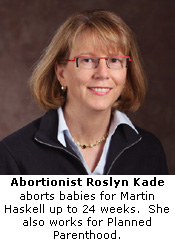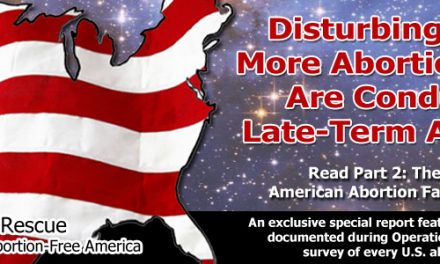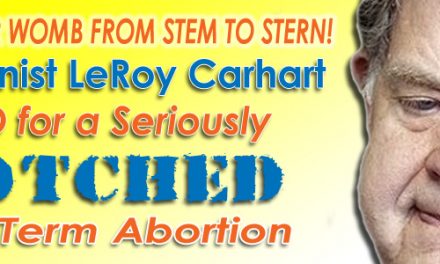[This is the second installment of a three part exposѐ on late term abortionist Martin Haskell’s special “variance” excusing him from complying with Ohio law. Click here to read Part 1.]
Dayton, OH – What you are about to read is a partial transcript of a emergency call to 9-1-1 dispatchers concerning an abortion-related medical emergency made from Martin Haskell’s Women’s Med Center outside Dayton, Ohio, on March 12, 2009.

Women’s Med Center: We have a patient who just is post-op on an abortion procedure and appears to be having some seizure-like disorder, and um, our anesthetist that is here just isn’t comfortable anymore.
9-1-1: Okay.
Women’s Med Center: We’ve tried reversal. She appears to be having some seizure activity.
9-1-1: Okay.
Women’s Med Center: She gave us no history of anything.
[snip]
9-1-1: That’s okay. About how old is she?
Women’s Med Center: She is twentyish.
9-1-1: Okay. Is she breathing?
Women’s Med Center: Yes. She is breathing.
9-1-1: Is she conscious now?
Women’s Med Center: No. She is not.
9-1-1: Okay. Is she actively seizing?
Women’s Med Center: Yes.
After a dozen years of legal wrangling, Martin Haskell’s Women’s Med Center abortion clinic in Kettering, Ohio, continues to operate on a “variance” from the state. While every other Ohio ambulatory surgical center is required to have a hospital transfer agreement in place in order to qualify for licensing, Haskell’s variance exempts him from this requirement.
No Dayton area hospital will grant Haskell hospital privileges or a transfer agreement.
“There’s a reason why no hospital will make a transfer agreement with Martin Haskell’s late term abortion mill,” said Operation Rescue President Troy Newman. “If every hospital in the Dayton area agrees that Haskell should not be practicing in their facilities, then he shouldn’t be practicing at all.”
Three enablers keep Haskell dangerously in business

Instead, Haskell has three staff physicians at Miami Valley Hospital who have agreed to treat his botched abortion patients. Without them, Haskell could not continue to operate in the Dayton area.
Those doctors are Lawrence Amesse, Sheela Barhan, and Janice Duke. All three are Obstetrician/Gynecologists affiliated with Wright State University Boonshoft School of Medicine.
“It is disturbing that Miami Valley Hospital would tolerate such an agreement,” said Newman. “This hospital and the three doctors are enabling Haskell to continue to operate under unsafe conditions. The recent 9-1-1 incidents are evidence of that.”
Two 9-1-1 calls made on behalf of Haskell patients earlier this year indicate that the Women’s Med Center have kept Amesse, Barhan, and Duke busy.
“Poster Boy” for Partial Birth Abortions
Martin Haskell became the “poster boy” for the now-banned Partial Birth Abortion procedure when he was the first to describe it in 1992 at a National Abortion Federation Risk Management Seminar where he coined the phrase “D&X” to identify the “Dilation and Extraction” procedure. In 1993, the American Medical News reported that Haskell admitted that 80% of the D&X procedures he had done on women were for purely “elective” reasons.
Haskell claims to have invented the grisly procedure, where a baby is partially birthed, then killed by evacuating the contents of the head and collapsing the skull before the head can be fully delivered. However, Haskell wrongly claims credit. The procedure was actually invented in 1983 by a California abortionist, James McMahon, of the often protested Eve Surgical Center, who died of a brain aneurism in October, 1995. Haskell’s false claims cast doubt on his truthfulness. What else is Haskell lying about?
With the passage of the Partial Birth Abortion Ban Act, abortionists who used the D&X procedure have shifted to the use of the “Induction Method,” which is virtually identical to the D&X except that before the procedure begins, the baby’s heart is injected with a lethal dose of Digoxin. (Read more about the Induction method.) The woman is then sent to her hotel room where she experiences labor, and returns to the clinic in time to deliver her dead baby.
While overall abortions last year decreased in Ohio by four percent, abortion statistics for 2008 show that last year there were 417 abortions identified as “D & Ext” or Dilation and Extraction, up a whopping 61% from the 254 similar procedures reported in 2007. Since this abortion method has been banned in the U.S., it is presumed that the report is referring to Induction abortions, which are very similar to Partial Birth (D&X) abortions. Ohio Department of Health reports show that, using various abortion methods, 603 abortions were done between 20 and 36 weeks of pregnancy when the risk of complications dramatically increases, and the concerns of life-threatening problems associated with the lack of a transfer agreement with a local hospital take on new urgency.
Unconscious and actively seizing
Operation Rescue has obtained two recordings of 9-1-1 calls made within seven days of each other for patients of Haskell’s Women’s Med Center. The recordings, made on March 12 and 19, 2009, raise questions about the safety of the clinic and the abortions done there.
On March 12, an employee of Women’s Med Center, located at 1401 E. Stroop Road in Kettering, placed a call to the 9-1-1 emergency dispatcher to report that a woman was unconscious and actively seizing after her abortion. [Listen to the actual 911 call here.] Dayton Right to Life procured the 911 documents for this incident and provided them to Operation Rescue.
Cover up throws patient under the bus
Along with the audio file of the 911 communication was a log sheet documenting the call and treatment by emergency responders. Information about the doctor, the name of the clinic, and the type of intervention the woman received was heavily redacted.
But shockingly, the patient’s name and contact information was untouched. Operation Rescue has pixilated her information to protect her privacy. [View document.] Note: The gray box-like redactions were done by the officials with the emergency communications office.
“It is very clear that patient privacy was of no concern to whoever redacted this document,” said Troy Newman. “HIPPA laws were never meant to protect the clinic or physician, but were enacted to protect the patient. But these people have stood HIPPA on its head. This document shows an obvious cover-up by the records custodian in Franklin County emergency communications on behalf of the clinic. That is the only reasonable motive for the extreme manner in which this document was redacted. They basically protected the abortion clinic and threw the woman under the bus.”
Just who was being protected and why? It is doubtful that Haskell was personally involved in the actual botched abortion, although his reputation and earning potential was no doubt at stake. An undercover phone call recently placed by an Operation Rescue investigator to Women’s Med Center confirmed that Haskell very rarely works at his Kettering clinic. Pro-life sidewalk counselors tell OR that they have never see him there.
The true Kettering abortionists

Two abortionists hired by Haskell to staff his Kettering clinic are Neil Strickland and Roslyn Kade. Strickland, 79, is an elderly man who graduated from medical school in 1956. He does abortions up to 12 weeks gestation. Kade, 58, of Cincinnati, aborts babies for Haskell up to 24 weeks.
Kade is also on the payroll of Planned Parenthood Southwest Ohio Region and is featured prominently in a promotional video for that organization identifying herself as an “abortion provider.”
Could it be that Haskell’s influence, along with Planned Parenthood’s political clout has convinced authorities to cover up for their abortion botches?
“Apparently the baby has fallen into the toilet…”
Seven days after the call from Women’s Med Center, another pair of 9-1-1 calls was made on behalf of a Women’s Med Center patient – but this time from a hotel.
In the two recordings, obtained by Operation Rescue investigators, a desk clerk is heard making the calls on behalf of the mother of a patient who was in labor. The mother told the clerk that her daughter was in the process of a “miscarriage.” After the clerk called for an ambulance, she placed a second call about 3 minutes later.
The clerk told the dispatcher, “Apparently the baby has fallen into the toilet and the umbilical cord – um, uh – the baby’s dead.” [Listen to Call 1; Listen to Call 2 ]
“This is completely in keeping with other late-term abortion situations that we have seen where women are sent into labor then return to their hotels where often they do not make it back to the clinic before they deliver their dead baby,” said Newman. “Labor and delivery of an infant – alive or dead – can be unpredictable and doesn’t always keep regular office hours so women sometimes deliver in hotel rooms, their vehicles, and other places.”
24 or 36 weeks?
This 9-1-1 call raises questions about how late abortions are being done at Haskell’s Kettering abortion mill.
While Haskell’s web site indicates that the upper gestational limits for a D&E (Dilation and Evacuation) abortion is 24 weeks, there is no upper gestational limit indicated on the “Fetal Indication” abortion page. Since many fetal anomalies are not detected until later in pregnancy, it likely that abortions well past 24 weeks are taking place at Haskell’s Kettering facility. In fact, records for 2008 show that abortions in Ohio were done as late as 36 weeks, the beginning of the ninth month of pregnancy.
Live births, law suits, and accusations of negligence
But these two emergency transport incidents are not Haskell’s only problems. He has been sued a number of times for botched abortions involving serious injuries such as torn holes in the uterus and bladder, lacerated uterine artery, perforated uterus, hemorrhage, incomplete abortions, and other problems. He has been accused of negligence in treatment of abortion injuries and of causing further injuries due to his negligence.
Dayton Right to Life reports that Haskell was responsible for two live births in 1989 and 1999 during failed abortions, and landed at least four women in the hospital between 1998 and 2002, two of which were forced to undergo emergency hysterectomies because of their injuries.
Even though there are abortion complication reporting requirements in Ohio, there is no way to know the true abortion injury rate since women experiencing problems are told to return only to the clinic where the complications can be quietly covered up. Ambulances are called only in the most dire of emergencies.
Then there is the question of Haskell’s truthfulness.
Above the law and dangerous
“The heart of the problem with Haskell is his unwillingness to comply with the law,” said Newman. “If he thinks he doesn’t need a transfer agreement, then maybe he doesn’t have to report all of the abortion injuries, either. His attitude that rules don’t apply to him makes him dangerous. The injury rate at Haskell’s Kettering facility alone has been said to account for 53% of all abortion complications in the state. How many more women have suffered than is being reported? It is clear that Haskell and his cohorts, Roslyn Kade and Neil Strickland, are not fit to practice medicine. Their hospital accomplices, Amesse, Barhan, and Duke are enablers who are placing the lives of women at risk.”
“Until the authorities are willing to enforce the law without variance, we can expect more frantic calls to 9-1-1. We can have all the abortion laws that we can think up, but if there is no one to enforce them, then those laws are worthless and women will continue to be the ones to pay the price with their health and perhaps even their lives.”
Coming Soon — Part 3: Overcoming Old Money and Extreme Politics That Keep Haskell In Business
[Thanks to our special investigative team in Ohio and to Dayton Right to Life for their contributions.]





